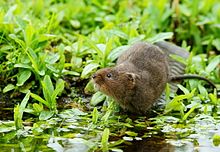Watervole
| European water vole | |
|---|---|
 |
|
| Scientific classification | |
| Kingdom: | Animalia |
| Phylum: | Chordata |
| Class: | Mammalia |
| Order: | Rodentia |
| Family: | Cricetidae |
| Genus: | Arvicola |
| Species: | A. amphibius |
| Binomial name | |
|
Arvicola amphibius (Linnaeus, 1758) |
|
| Synonyms | |
|
Arvicola terrestris |
|
Arvicola terrestris
The European water vole or northern water vole, Arvicola amphibius (formerly A. terrestris), is a semiaquatic rodent. It is often informally called the water rat, although it only superficially resembles a true rat. Water voles have rounder noses than rats, deep brown fur, chubby faces and short fuzzy ears; unlike rats their tails, paws and ears are covered with hair.
In the wild, on average, water voles only live about five months. Maximum longevity in captivity is two and a half years.
Water voles reach 14–22 centimetres (5.5–8.7 in) in length, plus a tail which is about half the length of the body. Weights reported for adults are variable. It is possible for large, optimal adults to weigh as much as 225 to 386 g (7.9 to 13.6 oz) However, these are peak weights. Elsewhere the mean body mass has been reported as 60 to 140 g (2.1 to 4.9 oz), although this figure includes immature water voles. The minimum weight to successfully breed as well as to survive winter is reportedly 112 g (4.0 oz) in females and 115 g (4.1 oz) in males. As a species the mean body mass is claimed as 140 g (4.9 oz).
Overall, European water voles are a uniform dark brown colour, with slightly paler coloration on the underside. Their pelage is quite thick and they are furred over their entire body, including their tail, unlike rats. Their dark colour allows them to blend in well in the densely vegetated areas they inhabit.
The binomial applied to the water vole is Arvicola amphibius, it was formerly known by the junior synonym A. terrestris. The confusion stems from the fact that Linnaeus described two species of water vole on the same page of the same work. Those two forms are now universally considered the same species. It has been recognized as A. amphibius (Linnaeus, 1758) because the first source to unite the two forms, which Linnaeus had treated separately, into a single species chose A. amphibius as the valid name. The species is widely known by the synonym A. terrestris which for many decades was treated as the valid name.
Some authorities consider the southwestern water vole (Arvicola sapidus) to be the same species, but this is now generally considered distinct.
The water vole Arvicola amphibius is found in most of Europe, Russia, West Asia and Kazakhstan.
...
Wikipedia

